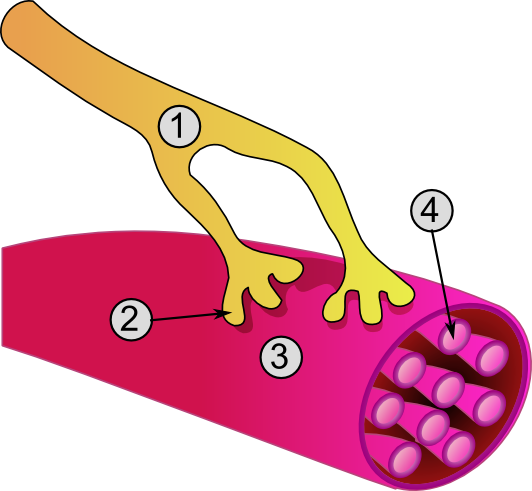Lambert-Eaton myasthenic syndrome: Difference between revisions
No edit summary |
No edit summary |
||
| Line 16: | Line 16: | ||
{{SI}} | {{SI}} | ||
{{CMG}}; {{AE}} {{RT}} | {{CMG}}; {{AE}} {{RT}} | ||
{{SK}} Eaton-Lambert syndrome; Lambert-Eaton syndrome; LEMS | |||
==Overview== | ==Overview== | ||
Revision as of 20:05, 3 August 2012
| Lambert-Eaton myasthenic syndrome | |
 | |
|---|---|
| Global view of a neuromuscular junction: 1. Axon 2. Motor end-plate 3. Muscle fiber 4. Myofibril | |
| ICD-10 | G73.1 |
| ICD-9 | 358.1 |
| DiseasesDB | 4030 |
| MedlinePlus | 000710 |
| MeSH | D015624 |
Editor-In-Chief: C. Michael Gibson, M.S., M.D. [1]; Associate Editor(s)-in-Chief: Raviteja Guddeti, M.B.B.S. [2]
Synonyms and keywords: Eaton-Lambert syndrome; Lambert-Eaton syndrome; LEMS
Overview
Lambert-Eaton myasthenic syndrome (LEMS) is a rare autoimmune disorder which affects the nerve-muscle (neuromuscular) junction.
The disease is usually observed in middle aged and older people but children and young people can be affected, as well. Due to the infrequency of the condition, the exact incidence is unknown.
History
Anderson was the first person to mention a case with possible clinical findings of LEMS in 1953, but Lambert, Eaton and Rooke were the first physicians to substantially describe the clinical and electrophysiological findings of the disease in 1966.[1][2] Auto-immune self antibodies to the pre-synaptic voltage gated calcium channels leads to neuromuscular block.
Pathophysiology
The disease is of autoimmune origin, that is, it is caused by antibodies that are directed against the antigens of the neuromuscular junction. In 1989, the previously anticipated antibodies were demonstrated to be directed against presynaptic calcium channels, which are located in neuromuscular junction (see synapse) and are responsible for the efficient release of acetylcholine. The antibodies prevent normal function of calcium channels and thus prevent the release of acetylcholine that is essential for normal nerve-muscle interactions, which maintain the normal muscle strength (see synapse, nerve, neuron, muscle).
There are also some patients that do not carry these antibodies in their serum samples and the exact cause of disease in these cases still remains to be determined. In cases with both LEMS and lung cancer (usually small cell type), the antibodies are suggested to be aimed at cancer cells and to bind and affect the antigens in neuromuscular junction accidentally. LEMS can be observed in other types of cancer including the transitional cell carcinoma of the bladder.
Approximately 50% of LEMS cases have an identifiable malignancy.
Causes
LEMS is usually a solitary diagnosis but lung cancer (small-cell histology) may accompany the disease in some cases. It may also be associated with cancers such as lymphoma, non-Hodgkin's lymphoma, T-cell leukemia, non-small cell lung cancer, prostate cancer, and thymoma.
Diferentiating from other Diseases
Both the etiology and the clinical findings of Lambert-Eaton myasthenic syndrome may resemble myasthenia gravis, but there are many substantial differences between clinical presentations and pathogenetic features of two disorders. In patients with affected ocular and respiratory muscles, the involvement is not as severe as myasthenia gravis.
Diagnosis
Symptoms
- The major clinical finding is progressive weakness that does not usually involve the respiratory muscles and the muscles of face. In patients with affected ocular and respiratory muscles, the involvement is not severe. The proximal parts of the legs and arms are predominantly affected.
- Many patients have autonomic symptoms like dry mouth or impotence. Reflexes are usually reduced or absent.
Laboratory Findings
- Antibodies to calcium channels
- Incremental response in repetitive nerve stimulation - incremental response is an increased response of muscle fibers to very high frequencies of electrical stimulation. Observed increase in the response of muscle fibers proves that there is a difficulty with the release of acetylcholine and this difficulty can be overwhelmed by intensive stimulation.
Chest X-ray
- Chest x-ray for a possible lung malignancy
Treatment
Corticosteroids, azathioprine and 3,4-diaminopyridine are used in treatment of LEMS with limited success. In some cases with a progressive and intractable course, plasma exchange or intravenous immunoglobulin can be tried.
3,4 diaminopyridine works by blocking K+ channel efflux in nerve terminal so that action potential duration is increased. Ca2+ channels can then be open for longer time and allow greater acetylcholine release to stimulate muscle at end plate.
References
- ↑ Template:WhoNamedIt
- ↑ E. H. Lambert, L. M. Eaton, E. D. Rooke. Defect of neuromuscular conduction associated with malignant neoplasms. American Journal of Physiology, Bethesda, Maryland, 1956, 187: 612-613.
Template:PNS diseases of the nervous system
de:Lambert-Eaton-Rooke-Syndrom Template:WH Template:WikiDoc Sources